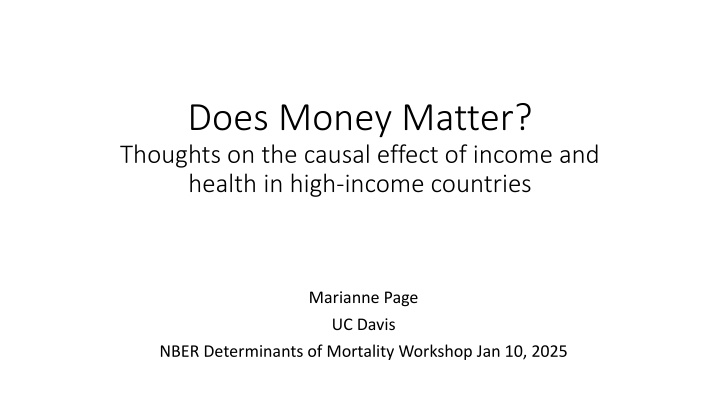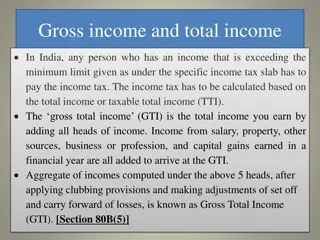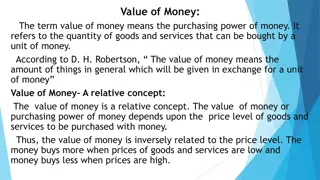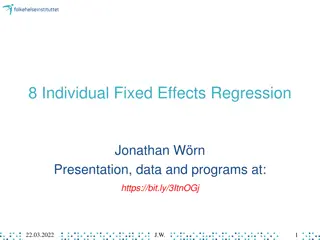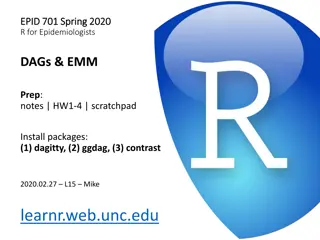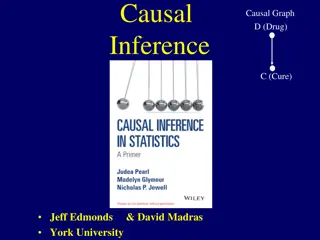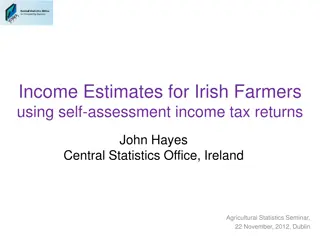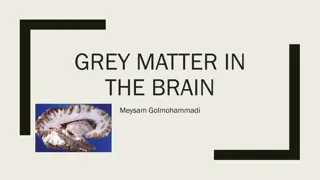Does Money Matter? Causal Effects of Income on Health in Developed Countries
New advances explore the causal effect of income on health outcomes in high-income countries, focusing on children's outcomes and adult health. Studies using natural experiments evaluate the impact of family income on various short and long-term outcomes in developed nations. Findings suggest that while increased financial resources generally improve children's outcomes, the causal effect of income on adult health remains inconclusive. Pure income interventions like lotteries show limited effects on health-related behaviors.
Download Presentation

Please find below an Image/Link to download the presentation.
The content on the website is provided AS IS for your information and personal use only. It may not be sold, licensed, or shared on other websites without obtaining consent from the author.If you encounter any issues during the download, it is possible that the publisher has removed the file from their server.
You are allowed to download the files provided on this website for personal or commercial use, subject to the condition that they are used lawfully. All files are the property of their respective owners.
The content on the website is provided AS IS for your information and personal use only. It may not be sold, licensed, or shared on other websites without obtaining consent from the author.
E N D
Presentation Transcript
Does Money Matter? Thoughts on the causal effect of income and health in high-income countries Marianne Page UC Davis NBER Determinants of Mortality Workshop Jan 10, 2025
New advances on an old question: Does money matter for childrens New advances on an old question: Does money matter for children s outcomes? outcomes? Critical summary of literature using natural experiments to evaluate the causal effects of family income on a variety of children s short and long-term outcomes in developed countries, especially the U.S. Existing studies have produced mixed evidence on whether policies that increase low-income families financial resources would make a difference Identification strategies included large one-time random shocks (e.g. lottery winnings), medium-size regular payments (e.g. casino disbursements) Included programs with work incentives and disincentives (e.g. EITC, NIT) Included cash and near-cash support (e.g. food stamps, housing vouchers) Focused on impacts for low-income families
Findings Findings Number of studies still relatively small differences in settings, samples of interest, outcomes measured, statistics reported, make it difficult to draw firm conclusions about why studies produce different estimates Most studies find that increases in families financial resources improve children s outcomes But studies finding little evidence that money matters tend to be based on larger samples, and produce more precise estimates Differences in results are not due to program s work incentives (disincentives) Studies that do not find evidence of positive effects tend to be based on one- time, unanticipated income shocks (e.g. lotteries) Studies that do find evidence of positive effects based on predictable, regularly distributed income support (e.g. casino distributions, EITC, SNAP)
a preponderance of evidence suggests that in developed countries today, income does not have a causal effect on adult health Cutler, Lleras-Muney and Vogl, 2011 Oxford Handbook of Health Economics Big data surprising number of studies still focus on self-reported health More natural experiments but some missed opportunities
Pure Income Interventions: Pure Income Interventions: Lotteries Lotteries No effects on child outcomes Adult health Cesarini et al. (2016) no effect on mortality or health care utilization; small reduction in consumption of mental health medication Other studies: little evidence of improvements in adult health or health related behaviors (Lindqvist et al. 2020; Ostling et al. 2020; Apouey and Clark 2015; Lindahl 2005) Except mental health
Casino distributions Casino distributions Improvements in adolescents educational and psychological outcomes (Akee et al. 2010 and Akee et al. 2018) Mechanism is parents mental health and parent-child interactions
Social Security Notch Social Security Notch Mixed evidence on adult health No reduction in mortality (Evans and Snydor 2006) No effect on weight (Cawley et al. 2010) Increases prescription drug use (Moran and Simon 2006) Improvement in cognitive functioning (Ayyagari and Frisvold 2016) Lowers nursing home use (Golberstein 2015)
2008 Stimulus Tax Rebates 2008 Stimulus Tax Rebates Lachowska (2017) reductions in adults self-reported stress levels
Income transfers tied to work: Income transfers tied to work: EITC EITC 1990s EITC expansions improved child outcomes along a number of dimensions Hoynes, Miller and Simon (2015) reduces smoking among pregnant women Improvements in adults overall health, mental health, biomarkers associated with metabolic syndrome; reductions in suicides (Boyd-Swan 2013, Evans and Garthwaite 2014, Dow et al. 2020; Rook et al. 2023) Canadian Child Benefit improved children s health and educational outcomes, reduced maternal depression, but no change in parents self-reported health (Milligan and Stabile, 2011)
Transfer programs with work disincentives Transfer programs with work disincentives Mothers Pension Program improved children s longevity, reduced underweight (Aizer et al. 2016), no effect on mothers longevity (Aizer et al. 2021) NIT- no change in children s SSI or SSDI receipt; no effects on adult mortality, but increases in disability benefit applications (Price and Song 2018)
SNAP SNAP Improves children s short and long-term outcomes (Almond et al. 2011; Hoynes et al. 2016; Bailey et al. 2023; East 2020; Bitler et al. 2022) Jones et al. (2018) find small reductions in adult mortality in poor counties
Job Loss Job Loss Most evidence on job loss and child outcomes finds that parental job loss has a negative effect on child outcomes. Exception Hilger (2016) who finds no impact of parental job loss on college attendance Job displacements increase adult mortality (e.g. Sullivan and Von Wachter 2009)
Summary of evidence on income Summary of evidence on income health relationship health relationship Patterns underlying my explanations for the differences in results for children are not as readily apparent for adults Differences in results do not seem to be due to whether the natural experiment is an unanticipated one-time shock/temporary vs. anticipated, regular payments More evidence that work incentives matter Programs with disincentives are less likely to find positive health effects Many different natural experiments find evidence that income improves adults mental health Few find evidence that income increases longevity Many studies that find evidence of health improvements rely on self- reports Many differences in settings, age groups, outcomes examined
To Do List To Do List Magnitudes and similar metrics for comparison More linkages to administrative data (e.g. Medicaid claims) Biomarkers Dial into low-income families Expand natural experiments (EITC, SNAP, Alaska Permanent Fund) Think carefully about processes that tie outcomes together
